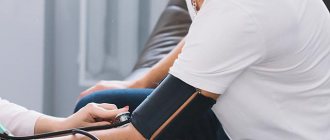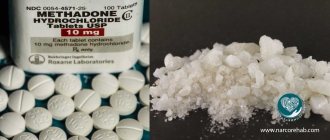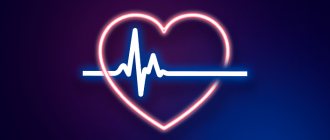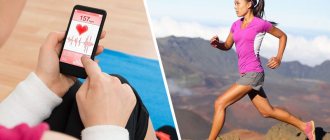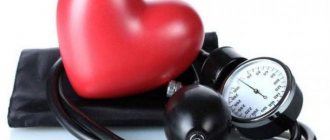Physical activity is stressful for the body and requires the expenditure of certain resources. To deliver additional resources to tissues and organs, the body increases blood circulation, causing the heart to work harder.
Sports should take into account individual indicators: breathing rate, pressure and, of course, the number of heart beats per minute (pulse).
The last standard is very important, since abnormal heart function after training (tachycardia, arrhythmia, bradycardia, etc.) may indicate a critical condition of the body.
The number of contractions of the heart muscle increases with physical activity and can reach 120 beats per minute.
If, after a certain time after stopping the exercise, the heartbeat is not restored, then diseases of the cardiovascular system should be excluded.
How the heart works while running
The heart is a muscle, which means, like any other muscle, it can be trained.
When we run, the body's (and muscles') need for oxygen increases significantly, which means the heart must deliver a larger volume of blood to them than at rest. The unit of measurement here is usually taken as the minute volume (MV), that is, the volume of blood that the heart can “distill” in one minute. It is calculated using a simple formula:
MO = SV x HR
What are these scary abbreviations? Let's explain.
Stroke volume (SV) is the amount of blood that the heart pumps out in one beat.
Heart rate is the number of heart beats per minute (almost the same as pulse). You can learn more about heart rate here.
As these indicators increase, the minute volume of blood also increases. It would seem that this is what we are trying to achieve? If heart rate increases, will minute volume also increase? Will the muscles receive more blood, will the body be able to cope with the load better? Not certainly in that way. When we run for a long time at a high heart rate, we simply do not allow the heart to rest between beats; it does not have time to pump enough oxygen, and we rather harm it than help it develop.
Normal heart rate recovery time after exercise or running
The recovery time for heart rate after exercise or running normally ranges from 5 to 15 minutes, sometimes the period of return to resting values occurs in half an hour. This depends on several factors:
- type of physical activity, its intensity;
- duration of the lesson;
- general condition of the body;
- recovery conditions.
The healthier and fitter a person is, the sooner his heart will begin to beat smoothly. After all, at rest it does not need an increased amount of oxygen, and therefore does not pump blood as actively as during training.
What is MCHSS
Pulse is an individual thing, depending on:
- age,
- physical fitness,
- body weight,
- presence of bad habits,
- simply on the level of stress.
Therefore, it is better to treat categorical recommendations to “train at a heart rate of 120” addressed to a wide audience with a healthy dose of skepticism.
How to calculate your personal norm?
Knowing your personal maximum heart rate (MHR), you can determine your pulse zones, and build your training plan in accordance with them.
MHR is the maximum number of heart contractions per minute that is achieved at the limit of the body's capabilities. It can be determined either in laboratory conditions, for example, in a sports clinic (the most accurate and accurate way), or using one of the formulas:
- Standard: MHR = 220 – (minus) your age
- More modern: MHR for men = 214-(0.8 x age), MHR for women = 209-(0.9 x age).
Missed heartbeat after exercise
Oleg
432 views
June 23, 2021
Hello, I’m 31. After minor physical activity, my heart begins to skip a beat. It doesn’t feel like extrasystoles because there is an extraordinary contraction first after a pause, maybe of course I’m wrong, I’m not a specialist in this) But the condition is very frightening, especially when such freezing occurs 5 times in a minute one after another as soon as, for example, I jump off the horizontal bar, and at these moments there is an unpleasant feeling in the throat. In November 2021, I had a mild form of Covid without damage to the lungs, after which I felt fine until February, I’ll say right away that I went in for sports immediately after Covid (. But in February, on the morning after an evening feast, after smoking 1 cigarette, I felt unwell, my limbs went numb, darkening in my eyes , a feeling of fear of death and a pre-fainting state. After drinking Corvalol 40 drops, it didn’t help, they called an ambulance and admitted me to cardiology. At the hospital, when they arrived, everything went away, while I was lying there I had an ECG a couple of times, a 24-hour holter, they took blood, urine, calla, and also did a CT scan of the chest It seems like I was in a standing position. All these tests find nothing, everything is absolutely normal. They are discharged when my condition improves, in the evenings I was sometimes still tormented by a feeling of fear, some kind of anxiety, I also did a separate ultrasound of the heart, which showed everything was normal, and an ultrasound of the thyroid glands (thyroid hormones are normal) discovered small nodules, the endocrinologist prescribed iodomarin for 6 months and said there was nothing wrong. And actually, since February, my life has been like complete hell, I have no feelings of fear for a long time, but to this day I am tormented by some kind of compression in the chest, fullness, heavy breathing, then I can’t exhale completely when I’m relaxed, then I can’t breathe in hard, and there’s a kind of pressure in my throat, I constantly feel my heart pulsating in my throat or in my chest, some kind of spontaneous muscle twitching, I’ve been following a complete healthy lifestyle since February I do sports moderately on the parallel bars, it even becomes easier, but I feel my heart strongly, but I’m used to it. and then literally 3 weeks ago I began to feel these fading described above and accordingly gave up sports and any physical activity. Of the tablets I take: iodomarin, afobazole 3 times a day (already 4 packs since February with breaks), panangin 3 times a day (I only drank half a pack), Nexium from the stomach I finish the pack (I have chronic gastritis since the army and the ulcer was 3mm, at the moment there are no ulcers), I constantly drip into my nose after Covid and my nose is stuffy, maybe that’s because of them. At rest, I don’t experience freezing or I experience it very rarely, but as soon as I do 40 push-ups from the floor and go one after another. Tell me, can I still undergo an ECG under stress, or some other heart examination? I heard that myocarditis occurs after Covid in 70% and can develop into chronic, what’s wrong with me? Maybe it’s just some kind of nervousness, or osteochondrosis of the spine (by the way, my back sometimes hurts in the morning and it’s stiff on the sides, but after exercise everything is fine) In 2021 I was lying with renal colic with an attack, but nothing was found, perhaps the sand had passed. What else can I say, and for about a year now I have been observing how my left side sometimes ache when I sit for a long time in the area somewhere between the pelvic bone and the pubic bone. Please give me some advice, these freezes scare me, what if it freezes and won’t start? Could this happen in my situation? I would be grateful for a good consultation, I’m already exhausted and don’t know what to do.
The question is closed
heart
arrhythmia
fading
COVID-19
Heart Rate Zones and Workouts
The heart rate zones, according to which it is recommended to build training (especially for beginners in running), are located between the readings of MHR and heart rate at rest (at a time when you are literally idle).
Experts identify five types of pulse zones. They do not have exact boundaries (remember that everything is individual!), and the difference between one zone and another is usually about 10%.
Also, pulse zones do not have uniform scientific names, but they have clear characteristics. Here they are (in sports gadgets, as a rule, they are indicated by colors):
Very Low Intensity Zone (White/Gray)
50-60% of maximum load. Warm-up area, intense walking or maximum light jogging. Training in this zone is comfortable and easy - it helps improve overall physical fitness and recover from hard work.
Low intensity zone (blue)
60-70% of maximum load. Fat burning zone. Training in this zone contributes to the development of general endurance of the body, the mobilization of fats (in this zone they are used to produce energy, not carbohydrates), and improve the functioning of the cardiovascular system. Many coaches advise doing about 80% of all running workouts in this zone - this is how we develop the heart, which means that over time we will be able to run faster, while expending less effort.
Aerobic zone (green)
70-80% of maximum load. Endurance training area. During training, the development of a network of small capillaries in the muscles is stimulated - which means that over time, oxygen will flow into the muscles more actively and faster. Attention - when running in this zone, lactic acid begins to enter the bloodstream.
Anaerobic zone (orange)
80-90% of maximum load. Maximum speed endurance is developed. Fats are practically not burned; the body uses carbohydrates to produce energy. Actively released lactic acid causes a quick feeling of fatigue in the muscles. Training in this zone should be high intensity but short.
Maximum zone (red)
90-100% of maximum load. The body and all its systems work to the limit of their capabilities. Lactic acid accumulates in the blood, and maintaining intense work for a long time becomes difficult and even dangerous. This load is called competitive, and running with such a heart rate regularly means working hard and putting your body in danger.
If the pulse takes a long time to recover after exercise: what to look for the reasons
When the pulse takes a long time to recover after exercise, this may be due to:
- Unpreparedness of the heart for active work. This happens if a person exaggerates his physical capabilities and trains too intensely. This is especially true for beginner athletes who do not yet know how to calculate strength. The load should be increased gradually, not forcefully.
- Cardiovascular disease. Their list is wide - from hypertension acquired with age to congenital defects that had not previously manifested themselves.
- The influence of hormones. What matters here is the intake of medications containing these substances (contraceptives prescribed for asthmatics, etc.), as well as the functioning of the central nervous system. The body itself is capable of producing excess amounts of hormones in diseases of the thyroid gland, pituitary gland, and genital area. The reason for this may also be nervous tension from fatigue or sports failure. Cortisol, adrenoline, and norepinephrine interfere with the restoration of a calm heart rhythm.
You should see a doctor if a decrease in physical activity does not help restore your heart rate within the allotted time. Moreover, if this is accompanied by severe weakness, hand tremors, and dizziness.
What do the experts say?
“Running by pulse helps me more accurately understand my condition before, during and after exercise, and always correctly determine my body’s response to the load. In addition, this is an indicator by which it is convenient to compare training results and track progress,” says MySportExpert manager Nina Sukhareva.
“It seems right to me to build my training schedule based on heart rate readings. I myself have some heart problems, so I make sure to do a control test twice a year - I update the readings of the pulse zones,” says Denis Titov, running expert.
Runners who took part in a poll on MySportExpert social networks also voted “for” heart rate training. To the question “Do you take heart rate data into account when planning your running training schedule?” 90% of participants responded positively.
Briefly
- Heart rate training is an effective and safe way to increase your endurance and improve your running performance.
- The heart is a muscle, and it can be trained. Running develops the heart if in our training plan we competently combine activities in different heart rate zones.
- It is recommended to carry out the main volume of training in the aerobic heart rate zone (alarm bell: if you cannot calmly carry on conversations while running, you have already left the aerobic zone).
- By running slowly, we develop our heart muscle, which in the future will give us a reserve for improving results, including speed.
- Recovery is the key to successful training. Don't push your body.
— Understanding heart rate zones and creating a training schedule, especially in the early stages, can seem like a daunting task. It is important to know that there is someone more experienced nearby who can help, guide and monitor. For example, during group classes under the guidance of an experienced trainer, you can completely devote yourself to training and trust a professional who will pay attention to each athlete and help make the training effective specifically for him. You can sign up for training on our website or by phone.
Arrhythmia after exercise can be sinus or atrial fibrillation
- Sinus is characterized by an uneven pulse, while its frequency may remain normal or slightly increased. This heart rhythm disturbance is not a contraindication to physical activity and does not threaten the patient’s health.
- Atrial fibrillation is characterized by rapid heartbeat after exercise and a chaotic pulse. In this case, the number of heartbeats cannot be determined without special medical devices. Each attack of atrial fibrillation can lead to disruption of blood flow, which, in turn, causes oxygen starvation of tissues and organs. Symptoms after exercise: confusion, dizziness or fainting, shortness of breath and breathing problems, panic attacks, discomfort in the heart.
If a patient with arrhythmia is not hospitalized in a timely manner, a myocardial infarction or stroke may occur.
